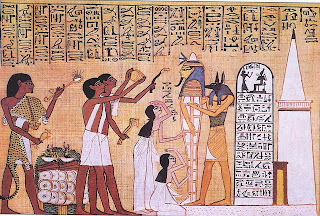Tuesday, November 26, 2013
The Royal Pantheon of the Basilica of San Isidoro in Leon (Romanesque)
This is the Royal Pantheon of the Basilica of San Isidoro in Leon. This is a depiction of Romanesque architecture. I think that it is amazing how the fresco art has survived over the years even after the depredation of Napoleon's soldiers. The paint covers almost all of the walls of the building and tells medieval and biblical stories. This scene is truly breath taking. I know that this is Romanesque because I can see the thick, solid-looking walls that support the weight of the heavy stone vaulting. In the picture above I can also see the engaged columns which are also a characteristic of Romanesque art.
Sunday, November 3, 2013
A Seated Buddha from the Xiangtangshan Caves
The Buddhist cave temples of Xiangtangshan, which translates as “Mountain of Echoing Halls,” are intended to replicate a Buddha’s paradise. The temple was a cultural achievement of the Northern Qi dynasty (A.D. 550-577), whose rulers established Buddhism as the official religion.The Xiangtangshan caves are located in a rural and coal-mining area in southern Hebei Province. A total of about 30 caves are divided among three sites, according to researchers at the University of Chicago’s Xiangtangshan Caves Project. The site was near the Northern Qi capital at Ye, and the early caves were created with the support of the royal family, officials, and Buddhist monks. This is a seated Buddha from the Xiangtangshan caves. It was a part of an exhibit called "Echoes of the Past: The Buddhist Cave Temples of Xiangtangshan" at NYU running from September 2012- January 2013. This piece was found and reconstructed from 3D digital technology and placed in this exhibition to allow people to experience the carvings in their original context and to better understand the sacred meanings it was meant to convey. I recognized this piece as a Buddha because of the elongated earlobes, chakras on his palms, the ushnisha, and the urna. This Buddha has a large halo that is embellished with floral and vegetal motifs. Most of the cave and artifacts were damaged due to a political upheaval in China. Most of the remaining Buddha sculptures have no heads or hands. I love how this piece has the halo and it depicts this Buddha as a happy being. He is smiling, and looks as if he is actually in the state of enlightenment.
Sunday, October 13, 2013
Our Lady of Perpetual Help (Byzantine Art)
This is a piece of Byzantine art called Our Lady of Perpetual Help. This piece depicts Mary (Mother of Jesus) sheltering a frightened young Jesus, who must have been running so fast, that his sandal is coming off. We then see the Archangels Michael and Gabriel on either side. I recognize this piece as Byzantine art because of the way Jesus' head is. In this time period, artists had not yet learned how to draw babies, or young children, so instead of looking like an actual baby, Jesus looked like a little man.
Monday, September 23, 2013
A Scene from the Ancient Egyptian Book of the Dead, 1300 B.C.
I have been so interested in the Ancient Egyptian way of art since we began the chapter in the book! The people's dedication to religion and their structured way of life is very intriguing. This is a piece from the Ancient Egyptian Book of the Dead. Although we learned about the Book of the dead in our textbooks, we studied a different part of it. In this picture, Hunefer's mummy is undergoing the "opening of the mouth" ritual in front of a funerary stela and a chapel. Three priests to the left are about to open his mouth so that he can speak, eat and drink in the afterlife. There are two mourning women in front of the mummy, and another priest wearing the mask of Anubis is holding the mummy. In this piece I see the gender differentiation with the women having lighter colored skin and the men having darker skin. Also, inside of the funerary stela, there are registers of hieroglyphs that tell a story. It is also seen that all of the men in this picture are portrayed as powerful or royal because of their royal stance.
Wednesday, August 28, 2013
Introduction
Hello,
My name is Melodie Miller and I am really excited to begin blogging about my new Art History Class! Stay tuned for more information. Below is a photo of myself.
-Melodie Miller
My name is Melodie Miller and I am really excited to begin blogging about my new Art History Class! Stay tuned for more information. Below is a photo of myself.
-Melodie Miller
Subscribe to:
Comments (Atom)






